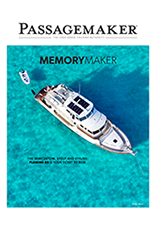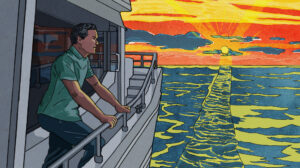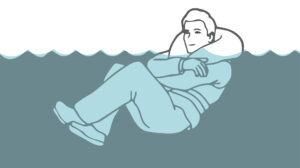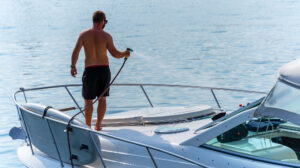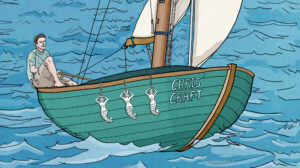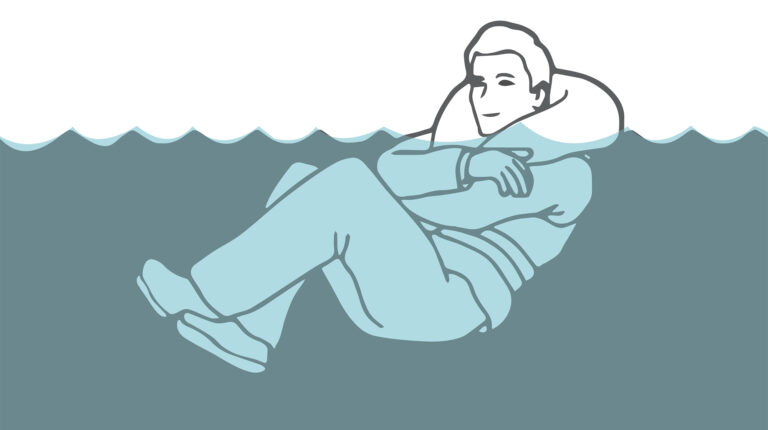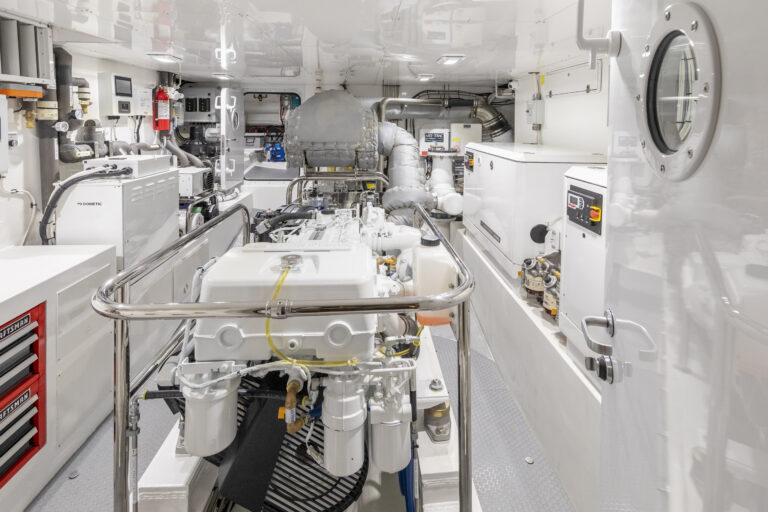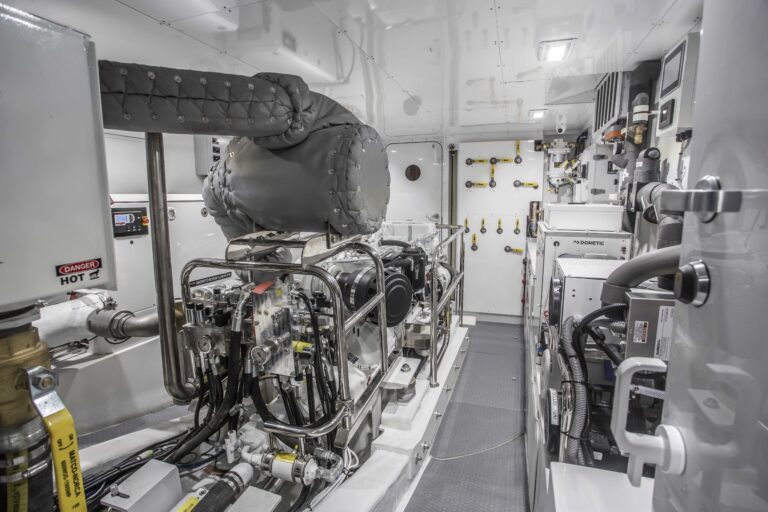
Pure and simple, education drives this unusual voyage. It really started in 1996, the year Ayla was born to Kathryn and David Besemer of Boulder, Colorado. As excited and proud as all new parents, they immediately began to plan for her education. Envisioning an opportunity for exposure to as many people, places, and cultures as possible, they considered alternative methods of teaching and learning.
Both successful in their chosen careers, David as a technology officer of a software firm, and Kathryn as a marketing consultant, they quickly decided that Kathryn would resign and become a full-time mom. Since both had traveled frequently and had seen much of the world, they thought, “What better education could we provide for Ayla than a travel-based experience?” But knowing how difficult travel can be, particularly as a family with a child, they began looking at alternatives. They targeted her middle school years to have a plan in place.
A few months later while traveling on business, David picked up a copy of PMM in a Los Angeles coffee shop. He had never seen nor heard of the magazine before, but a front cover photograph of a Nordhavn captured his attention. After ordering reprints of all past issues, he and Kathryn began pouring over them. Based on their research, they put together a list of boats to look at including Krogen, Selene, and DeFever.
“We were impressed with the strength and quality of the Nordhavns right from the start,” said Kathryn. “We felt that if we could learn about cruising from the ground up, a boat like that could take us anywhere in the world. It would become a platform for learning about science, weather, navigation, and self-reliance, in addition to learning about people, places, and culture,” she added.
Back in Boulder, the Besemers spent the next few years reading all they could about trawlers. When Ayla was in second grade, they booked a one-week charter on a Mainship 34 trawler in the Abacos. This was their very first boating experience as a family and they all loved it.
Wanting to experience boating in a foreign country, the following year they booked a two-week charter on a powerboat in Greece. Ayla relished the experience of being in a foreign country. Now that the last hurdle had been crossed, it was time to make the decision. In 2008 they decided to go for it.
MOVING ABOARD
Taking into account the cost of an ocean-capable trawler and operating expenses, they made the decision to sell their house in Boulder. David arranged a one-year leave of absence from his job to begin their voyage. Kathryn and Ayla looked into home-schooling resources and ultimately chose the Calvert School, known for high-quality programs through the eighth grade.
After further evaluating trawler models, the Besemers settled on Nordhavn. They looked at a used, 2006 43-footer that had only recently been commissioned and had less than 200 hours on the engine. It was also equipped with TRAC stabilizers. Its draft and lower height gave them good access to the cruising areas they planned to visit. “As soon as I walked aboard, I knew this was the one,” said Ayla.
Their offer on the 43 was accepted on August 2, 2008—all according to plan. They took delivery in Stuart, Florida, and the insurance company gave them two weeks to depart the state, as it was in the middle of hurricane season. The family spent the first week on orientation, sea trials, moving aboard, and finding a captain to help them move the boat out of Florida and into Chesapeake Bay.
New to boating, they decided to stay within the coastal boundaries of the eastern United States and experience a wide variety of cruising conditions to familiarize themselves with the cruising life. In addition to learning all they could about boating, the time would also be spent learning how to observe, record, and transmit their experiences with camera, video, writing, and building a blog audience.
After waiting out the hurricane season, they left on their first voyage. They spent a month transiting the eastern ICW with two runs offshore, the last a 40-hour trip from St. Mary’s, Georgia, to Port Everglades, Florida. “I was glad to experience the ICW, but it was a lot of work, and progress was slow,” said David.
Bahamas Bound
The first offshore trip for Three@Sea was from Ft. Lauderdale to Nassau, Bahamas. The boat did not have a satellite weather receiver on board at the time and encountered stiff easterlies and head seas, which David described as “the worst we had encountered up to that point.” Ayla pitched in, “Yeah—sea, sky, sea, sky.” Dave immediately ordered an Iridium satellite phone, which receives multiple email weather predictions, giving them the ability to check the weather in real time on a regular basis.
During the next four months they cruised the Bahamas through the Exumas, as far south as Georgetown. Much of their time in the island chain was spent snorkeling and diving with Ayla increasing her devotion to the ocean while observing sea life from just inches away. In Cape Eleuthera, the Besemers were introduced to The Island School, a private school with emphasis on the environment and sustainability. Ayla developed a presentation, Save Our Seas, to share with the students and was honored to make her first presentation on the environment while visiting the school.
By the end of March 2009, Three@Sea had returned to the United States. Having been gone for four months, the family missed the clear water and slow pace of life in the islands, but they were glad to return to the cornucopia of fresh vegetables, meats, Costco, and Home Depot.
At this point the family decided on the next phase of their voyage—they wanted to spend the summer and fall cruising north to the Great Lakes, crossing through Canada into the St. Lawrence Seaway, and visiting Canada’s Maritime Provinces before heading back south and on to Panama. They were sure the variety of cruising conditions they would encounter on this voyage would adequately expose them to all possible situations at sea.
NEW YORK, THE HUDSON, AND THE ERIE CANAL
The Besemers left St. Augustine, Florida, bound for New York on an 800nm offshore run. David spent considerable time evaluating the weather window and it proved to be excellent for the entire 111-hour trip.
On April 26, 2009, they arrived in New York Harbor at night, keeping a careful watch for commercial traffic and working to distinguish navigational aids from thousands of shore lights. They tied up at the 79th Street Boat Basin, but after a couple of nights exposed to the wash of passing traffic, they picked up a mooring ball. “It was a bit less convenient because of the dinghy ride, but where else can you stay in Manhattan for $30 a day?” said David.
After five days visiting friends and family, it was time to head north on the Hudson for the next leg of their journey, which would take them through the Erie Canal and into the Great Lakes. The objectives of this phase of the trip were to experience locks, visit David’s family home on Harsens Island, Michigan, and see the North Channel and Georgian Bay of Canada.
For the next two days, they cruised up the Hudson River and enjoyed the colors of spring foliage, the impressive estates, and the walls of the U.S. Military Academy at West Point. The town of Waterford, New York, at the entrance to the Erie Canal was the highlight of the Hudson for the Besemer family.
After two days in Waterford, Three@Sea continued westbound on the Erie Canal. At the end of May 2009, they arrived in Lake Erie with the Hudson River, the Erie, Oswego, and Welland Canals, and Lake Ontario behind them.
Next up was David’s mother’s home on Harsens Island. David had enjoyed boating there as a child, aboard a 12-foot skiff and a 24-foot Chris-Craft Woody, never dreaming that the experience would eventually lead to calling a Nordhavn home. During their stay they made many upgrades to the boat: a fixed antenna for their satellite phone, screen doors for the pilothouse, mounting a new kayak, and replacing their mattresses.
The North Channel and Beyond
The next phase of their voyage took them to the North Channel and Georgian Bay. After a 40-hour voyage up Lake Huron in stormy weather and a stop at Mackinac Island, they cleared Canadian customs in Meldrum Bay.
Little Current, located on Manitoulin Island, is the crossroads of the North Channel. Besides having everything a cruiser needs within a short walk from the town dock, it is also home of the Little Current Yacht Club, located in an upstairs room of the Anchor Inn. Roy Eaton, commodore of the club, hosts a cruisers’ net each morning at 9 a.m. on VHF Channel 74, which is an excellent source of cruising news, weather, and up-to-the-minute commentary on the North Channel. He had read about the Besemers’ voyage on the Internet and asked Ayla to broadcast her “Save Our Seas” presentation over the air.
After two weeks of cruising the North Channel and the northern coast of Georgian Bay, the family arrived at Port Severn in the southeast corner of the bay. Port Severn is the western terminus for the Trent-Severn Waterway, a 240-mile canal system containing 43 locks and the unique Big Chute Marine Railway. While old hands at locks by now, they learned another skill as they transited the marine railway, which is basically like a large, submerged railroad car. Once inside, your boat rides in the car up a railway and into the water on the other side of a 60-foot rise. At the end of this amazing system of canals, lakes, and locks, Three@Sea was back on Lake Ontario.
Arriving in Kingston, Ontario, on August 8, 2009, it was time to make a major decision: Should they return to the Erie Canal, or continue out the St. Lawrence Seaway to cruise the Maritime Provinces of Canada? Because the journey they were taking was more about learning and gaining experience rather than sightseeing, the Besemers decided to head east by north. They knew they would encounter more commercial traffic, cold weather, and fog; just what they needed to round out their first voyage.
During most of the trip up the seaway visiting Montreal, Quebec City, and many small fishing villages, it was necessary to dock Three@Sea as anchorages were few and far between. Also, the limited amount of facilities available made it important to have a careful plan to get from one point to another. They made the 140-mile trip from Montreal to Quebec City in only two days due to the current raising their speed from 7 knots to better than 9. On August 25, they reached Gaspe, Ontario, the turning point to continue the voyage in a southerly direction.
CANADIAN MARITIMES
The Besemers spent a few days waiting to see the track of Tropical Storm Danny before resuming their cruise. Because they were a bit behind schedule, they chose a 27-hour passage from Gaspe to Prince Edward Island. It was a long overnight slog through 6- to 8-foot seas down the Northumberland Strait. Their arrival in Summerside, P.E.I., lived up to its name with an afternoon of sunny skies and subsiding seas.
Here they dined out at Flex Mussels restaurant, where Ayla learned three different ways to eat the shellfish. They said the quaint architecture and active fishing fleets were surpassed only by the friendliness of the people. They also noticed the first sign of the changing seasons as they watched the local pleasure boats being unpacked and hauled. It was time to move on to Nova Scotia for a couple of weeks before heading home to the United States.
Most of their time was spent in Halifax, Lunenberg, and Shelburne, each town exhibiting a different type of Nova Scotia charm.
Halifax, although the largest city in the Maritimes, is filled with renovated and preserved buildings within walking distance of the downtown public wharf where Three@Sea was docked. Kathryn enjoyed the fresh produce from the farmer’s market, the oldest in North America, located across the street from the dock.
If Halifax is the commercial center of Nova Scotia, Lunenberg is the tourist center, and for good reason. Historic preservation is king, followed closely by maritime history as represented by the Bluenose schooner and the Fisheries Museum of the Atlantic, where they docked for their visit.
Shelburne was the final chapter in their visit to Nova Scotia. They participated in the historic town’s annual chili cook-off and the Whirligig Festival.
On September 20, 2009, Three@Sea left Shelburne on her final voyage out of Canada, across the Bay of Fundy, and back into the United States. After some initial challenges from strong currents generated by the extreme tides, they enjoyed a smooth cruise into the Gulf of Maine where they saw the colorful floats of the lobster traps.
AUTUMN ON THE EAST COAST
Having arrived in New England so late in the season, the shorter days and smaller weather windows dictated a quick passage down the shore with stops at Marblehead and Boston, where Ayla celebrated her 13th birthday. She had been invited to give her “Save Our Seas” presentation to a youth group and they were prepared for her visit, complete with a nautical-inspired birthday cake. The Besemers then moved on to Portsmouth, Rhode Island, where they tied up at the docks of the Northeast offices of Nordhavn. It was a coming-home party of sorts, with Nordhavn personnel and other owners sharing in the joy of their year-long cruise.
With Cape May, New Jersey, as their next destination, an unusually placid forecast gave them an opportunity to cruise down to the Delaware/Maryland shore and into Norfolk, Virginia. As they passed the entrance to New York Harbor, the family closed the loop they had started in late April. In approximately six months they had accomplished their goal: A family of three with little cruising experience when they began this loop, were seasoned veterans as they moved on to Norfolk. It was hardly a leisurely cruise, but a great education for Ayla, David, and Kathryn. As they prepared themselves and the boat for the next phase of their journey, the Besemers spent the winter of 2009–10 in Florida and the Bahamas and returned to the Chesapeake in the spring. David went back to work, commuting by air to his office in California, and visiting customers around the world. Ayla and Kathryn stayed with the boat while working on possible sponsorships from media who might be interested in this unique voyage.
SNOWBIRDS HEAD SOUTH
After spending the summer cruising the mid-Atlantic coast, the family spent the month of November 2010 in New Bern, North Carolina. December found them back in Florida preparing to depart on the next leg of their voyage: a 1,000nm cruise through the Bahamas chain, on to Turks and Caicos, and then south to Puerto Rico for the winter. David took two weeks off from work for the trip and they dropped anchor off the island of Culebra on December 27, just in time to celebrate a late Christmas.
They took up residence in the SunBay Marina in Fajardo, located on the northeast coast, not far from San Juan and the airport. The location gave them good shore access to visit Puerto Rico, a number of good short-distance cruising destinations, as well as a perfect spot from which to explore both the U.S. and British Virgin Islands.
In May, 2011, they departed on their most adventurous voyage yet: a 2,026nm, 12-day passage to Rhode Island. They had light winds and calms seas all the way back to the Florida coast, where they turned to starboard following the Gulf Stream north at increased speed over the ground.
While transiting the Georgia coastline, they saw a mysterious image on their radar. They kept an eye out for whatever it was and soon were surprised by a submarine surfacing about a half-mile off of their port beam!
BACK IN NEW ENGLAND
Right on schedule, 12 days after their departure, Three@Sea made landfall at East Greenwich, Rhode Island. As David’s blog records: “It was definitely a voyage for our record books and one that we will never forget. Our boat and its systems performed flawlessly for the entire journey. This kind of voyage is a testament to the vision and workmanship of the folks at Nordhavn (not to mention Northern Lights, TRAC, Furuno, and other systems providers). These boats are rock-solid platforms for extended bluewater cruising, and we are so happy to call one our home.”
They spent the summer of 2011 in New England while David continued to fly in and out on business. They kicked off the season with a trip to Nantucket, Massachusetts—another lesson in cruising in heavy fog.
One of the summer highlights for Ayla was publishing her first article in the August 2010 issue of Astronomy magazine titled, “Why Teens Should Care About Astronomy.” Quite an achievement for a 14-year-old. Ayla is now enrolled in EPGY OHS, a virtual high school program produced in association with Stanford University.
I spoke with the Besemer family on Three@Sea last August via a Skype connection. They were located at a marina in Warwick, Rhode Island, preparing the boat for Hurricane Irene, due to pass through late in the week. They were planning to put her on storm anchors in a well-protected bay nearby. I have since heard from them and all went well.
The family’s diligence obtaining media attention has paid off. Last October, they spent 11 days with Atherton Pictures filming a pilot/special episode about their journey. Who knows? This story may end up in a wholesome reality show. After filming, the family planned to return to Puerto Rico. They enjoyed the territory so much last year that they wanted to go back for the winter.
WHAT THE FUTURE HOLDS
This spring, the Besemers plan to head west for the Panama Canal and then spend the summer cruising the west coast of California. If they secure a media partner and/or David’s full retirement, they will follow the setting sun for the South Pacific.
As we discussed the segments of the voyage, David said, “The first year we were actively cruising. The last two years we have been living aboard in a holding pattern, cruising the East Coast of the United States, hoping to continue our around-the-world voyage again.”
As a family, they wondered if they would grow tired of living aboard. Many of their family and friends have encouraged them to sell the boat and return to life ashore. “We had no intention of becoming liveaboards,” Kathryn said. “We did it to cruise. But we did the hard part—selling the house and the cars, getting moved aboard—and achieved a steep learning curve that first year.”
They have a pact that is based on a unanimous decision by all three family members: As long as there is a chance that they can continue, they will stay out. To move back ashore and then subsequently try to make all the arrangements to head to sea again would be very difficult. Others have suggested that they fulfill their dream when they are older and in full retirement, but Kathryn says they are missing the point. “We want to do this trip as a family and as a unique educational experience for Ayla,” she said.
After following the Besemers and their voyage aboard Three@Sea for three years, I believe they will accomplish all they set out to achieve. It already has the makings of a significant and successful cruise, one that is as unique as the family itself.
VOYAGE
*Miles Traveled: 11,175nm
Days Living Aboard: 658
Longest Passage: 111 hours
Locks Transited: 70
States Visited: 14
Countries Visited: 3
*Includes coastal trips before and after the loop cruise.
Three@Sea SPECIFICATIONS
Builder: Nordhavn
Year: 2006
LOA: 43′
Beam: 15′
Draft: 5′
Cabins/Heads: 2 / 2
Displacement: 54,500 lb.
Main Engine: 110hp Lugger
Wing Engine: 60hp Yanmar
Fuel Capacity: 1,200 gal.
Cruising Speed: 7 knots
Range: 3,000nm
